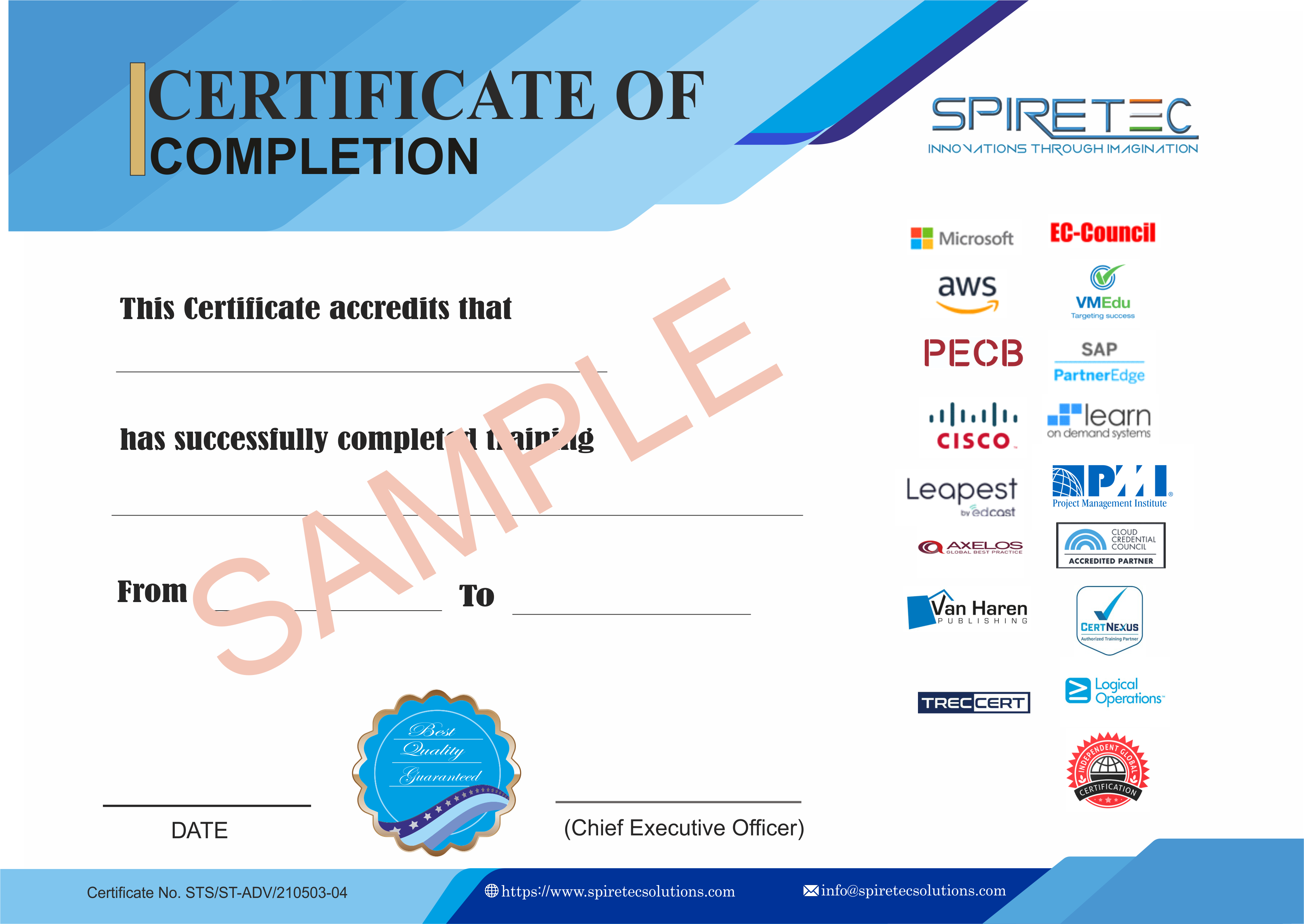55216 : SharePoint 2013 Power User course delivers the complete site owner story from start to finish in an engaging and practical way to ensure you have the confidence to plan and create new sites or manage your existing sites. Your goal is to learn how to make SharePoint relevant to your team by using a site’s functionality to help you share information and collaborate with your colleagues. During the class, you will also learn best practices and ‘what not to do’ as you watch live, interactive demonstrations and put theory into practice with hands-on exercises. This course gives you the confidence to plan and develop new sites or maintain your existing sites by telling the entire site owner story from beginning to end in an interesting and useful way.
Audience Profile:
This course is intended for anyone who wants to become the ultimate site owner, whether you are building sites for yourself or helping others create and maintain their sites.
At Course Completion:
After completing this course, students will be able to:
-
Understand and describe the functionality of SharePoint 2013.
-
Create and delete sites.
-
Create and manage web pages, including content such as pictures and videos.
-
Define business information and retention to standardize and automate content creation and management.
-
Add and configure apps to make sites relevant to specific business requirements.
-
Build processes with workflows.
-
Customize security.
-
Communicate using social tools, including newsfeeds and community sites.
-
Work with search.
-
Build business scenarios using combinations of the above techniques to solve real-world problems.
Prerequisites:
Course Outline:
Module 1: An Introduction to SharePoint 2013
Let’s get started with SharePoint 2013 by letting you know about its fantastic selection of features. We will demonstrate popular uses of SharePoint 2013 to manage and share content, create engaging web pages, automate business processes, and make good business decisions with Business Intelligence.
We will also discuss who will be the typical users in our sites and the role of the site collection administrator. Site Owners are trusted with functionality that, in other business systems, would normally only be available to developers. As a new Site Owner, we’re sure that you will be amazed by the potential that SharePoint 2013 has to offer an end user.
Lessons
-
An Overview of SharePoint 2013
-
SharePoint Versions
-
Central Repository for Information
-
Roles in SharePoint
-
Web Content Management
-
Site Visitors
-
Team Collaboration
-
Site Members
-
Search
-
Site Owners
-
Social Computing
-
Site Collection Administrator
-
Workflows
-
Farm Administrator
-
Business Intelligence
-
Security Trimming
Lab 1: Navigate SharePoint
After completing this module, students will be able to:
-
Describe the key features of SharePoint 2013
-
Navigate around a site and between multiple sites
-
Understand the roles of different people in SharePoint, from Farm Admins to Visitors
Module 2: Creating Sites
Whether you are managing existing sites or you have not yet started, we will complement your current situation by discussing site hierarchy and planning your SharePoint sites.
As a site owner, you will be presented with a selection of site templates. You will use a variety of popular site templates to develop an enhanced understanding of each site's function and appropriate use. Once your site is ready, we will then change the look and feel of your site. You can even try applying your business brand to your test site. We will also build our navigation bar, a simple but powerful way to help users move between websites.
Lessons
-
An Introduction to Site Topology
-
Navigating SharePoint Sites
-
When to Create a Site and Where?
-
Applying Custom Themes to a Site
-
How to Create a New Site
-
Building the Site Navigation Bar
-
Site Templates
-
Deleting Sites
-
Team Sites
-
Recovering Deleted Sites
-
Project Sites
-
Blog Sites
-
Community Sites
-
Publishing Sites
Lab 1: Create and Delete Sites
-
Create a new Team Site
-
Delete a Site
-
Restore a Deleted Site
After completing this module, students will be able to:
Module 3: Creating and Managing Web Pages
SharePoint boasts a rich selection of ways to build web pages. You will learn how to update the home page of your SharePoint site with text, links, images, videos, and web parts. We will also show you best practices when creating multiple pages and linking them together.
In most site templates, creating and managing web pages is a simple, fast, and rewarding way to present essential information and apps.
SharePoint can also be used as an Intranet for internal news and information, as well as a public-facing website. Due to the high visibility of these websites, it is common to place more control over the release of new web pages or updates to existing pages. For this reason, SharePoint has Publishing Sites.
Lessons
-
Introducing Wiki Pages
-
Introducing the Publishing Site
-
Adding Wiki Pages
-
Create and Edit Publishing Pages
-
Adding Rich Content to Wiki Pages
-
Using Page Layouts
-
Promoted Links
-
Web Page Metadata
-
Adding and Modifying Web Parts
-
Site Collection Images
-
Deleting Wiki Pages
-
Renditions
-
Reusable Content
-
Web Page Approval
-
Scheduling Pages
Lab 1: Create and Update Pages
After completing this module, students will be able to:
-
Describe the types of pages available in SharePoint
-
Create, Edit, and Delete Pages
-
Work with page content including text, tables, links, images, and video
-
Use publishing to control who can see page content during updates
Module 4: Defining Business Information & Retention
Traditionally, teams make use of file templates or manual processes to ensure information is collected and retained correctly. In this module, we will help your team establish reusable file templates and automate business processes. An example of this would be removing old unwanted content from your site automatically.
To achieve this, you will learn about a variety of SharePoint features including content types, policies, and in-place records management.
Lessons
-
Managed Metadata Service
-
Information Management Policies
-
An Introduction to Content Types
-
The Records Center
-
Create & Manage Content Types
-
The Content Organizer
-
Content Type Settings
-
Document IDs
-
Using Content Types in Apps
-
In-Place Records Management
-
The Content Type Hub
-
Deploying Content Types
Lab 1: Defining Business Information and Retention
-
Create and test an invoice content type
-
Switch on and test In-Place Records
-
Create and test a Content Organizer rule
After completing this module, students will be able to:
-
Describe the key features of SharePoint 2013 to collect and retain business information
-
Use and configure Content Types, Managed Metadata, and Columns
-
Create and edit policies
-
Manage Records in place and with Record Centers
Module 5: Adding and Configuring Apps
Apps are required to store information such as events, contacts, and files in a site. SharePoint provides a selection of apps for different scenarios, all with the option to be customized for a specific business requirement. Apps can be broken down into Lists, Libraries, and Marketplace Apps.
In SharePoint 2013, lists serve as the structure for calendars, discussion boards, contacts, and tasks. This module explains the concept of lists and then reviews popular options.
A document library is a location on a site where you can create, collect, update, and share files including Word, Excel, PowerPoint, and PDF. We will show you the benefits of using a library and teach you how best to work with files in a library.
An introduction to on-premises and SharePoint Marketplace apps is provided to show how to extend site functionality beyond what Microsoft has provided in the SharePoint 2013 platform.
Finally, this module provides an essential overview of the Microsoft products that are most commonly used in conjunction with SharePoint 2013 and discusses the advantages of each program when combined with SharePoint.
Lessons
-
Adding List & Library Apps
-
Popular List & Library Templates
-
Managing List & Library Settings
-
Add, Modify, Upload, and Delete Content in Apps
-
Create and Manage App Columns
-
Adding Site Columns
-
Sort and Filter Content
-
Create and Manage Public Views
-
Personal Views
-
Working with Document Sets
-
Using Alerts in Apps
-
Creating App Templates
-
Office 2013 Integration with SharePoint Apps*
-
On-Premises Apps
-
SharePoint Marketplace Apps
Lab 1: Working with Apps Lab 1
-
Create a new library
-
Create columns and views
-
Create a document set
Lab 2: Working with Apps Lab 2
-
Upload and manage files
-
Create a new view in a library
-
Create and delete announcements
-
Test SharePoint alerts
-
Update items in Quick Edit view
After completing this module, students will be able to:
-
Create Apps to store business information including documents, images, and videos
-
Customize apps to make them relevant to their business requirements using columns, views, and app settings
-
Use apps with other office applications such as Excel and Outlook
Module 6: Building Processes with Workflows
Workflows are a powerful efficiency tool that can be used to organize and track process-driven tasks, including approval processes. Workflows will be demonstrated using real-world examples. You will be given the opportunity to build workflows and review workflow progress. Also covered is an introduction to Microsoft SharePoint Designer 2013 and third-party workflow tools.
Lessons
-
An Introduction to Workflows
-
Adding Workflows
-
Workflow Scenarios
-
Removing Workflows
-
Creating Workflows
-
Third-Party Workflow Tools
-
Configuring Workflow Settings
Lab 1: Create and Run Workflows
After completing this module, students will be able to:
-
Understand when to use a workflow
-
Create and edit workflows in the browser
-
Use workflows to collect approval and feedback information
Module 7: Customizing Security
Security is an important element of any site. You will see instructor-led demonstrations of the best practices for adding and removing colleagues from your site and defining their level of access. As a site owner, you can customize permission levels.
Lessons
-
An Introduction to Security
-
Creating Groups
-
Access Requests
-
How Inheriting Security Works
-
Share Sites and Files
-
Securing Apps, Folders, Files/Items
-
Approving Access Requests
-
Managed Metadata Security
-
Creating Permission Levels
-
OneDrive Security
Lab 1: Customizing Security
-
Add colleagues to your site and assign them permissions
-
Create a group for the site
-
Set permissions for that group
After completing this module, students will be able to:
Module 8: Communicating with Social Tools
SharePoint offers a selection of social tools for your business to help keep everyone informed. Users can communicate and share using tools like Community Sites, Blogs, and Newsfeeds.
Lessons
Lab 1: Update User Profiles
After completing this module, students will be able to:
-
Use SharePoint's social tools to encourage collaboration
-
Create and manage Blogs and Community sites
-
Leverage Newsfeeds to keep team members informed
Module 9: Working with Search
Finding information quickly is a critical component of business. SharePoint includes search tools that can help you locate information efficiently.
Lessons
-
Understanding the Search Architecture
-
Searching in SharePoint
-
Understanding Search Results
-
Creating Managed Properties
-
Managing Search
-
Search Customization
-
Search Best Practices
-
Working with Refinements
Lab 1: Conducting Searches
After completing this module, students will be able to:







 Live Online Training (Duration : 32 Hours)
Live Online Training (Duration : 32 Hours)
